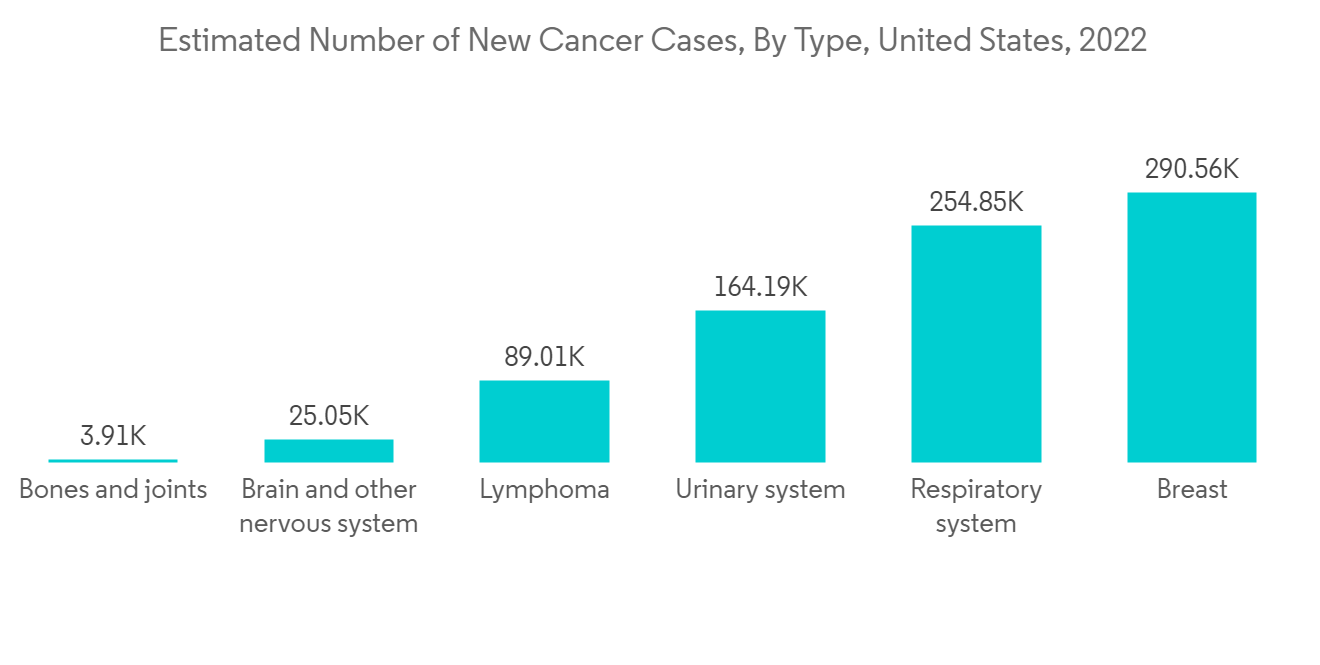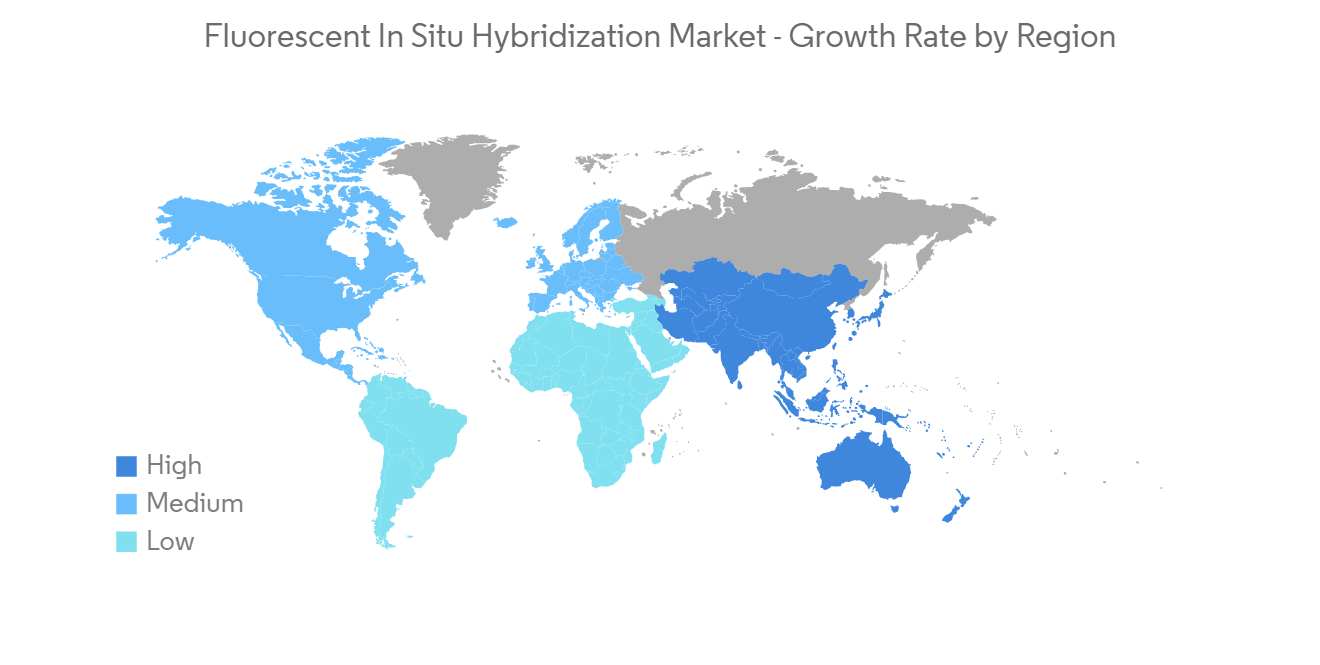 |
市場調查報告書
商品編碼
1273332
FISH(熒光原位雜交)市場——增長、趨勢、COVID-19 影響和預測 (2023-2028)Fluorescent In Situ Hybridization Market - Growth, Trends, and Forecasts (2023 - 2028) |
||||||
※ 本網頁內容可能與最新版本有所差異。詳細情況請與我們聯繫。
FISH(熒光原位雜交)市場預計在預測期內以 6.8% 的複合年增長率增長。
由於部署 FISH(熒光原位雜交)的研究激增,COVID-19 對監控市場產生了巨大影響。 例如,2022 年 11 月發表在 PLOS One Journal 上的一篇論文使用 FISH(熒光原位雜交)檢測唾液中的 SARS-CoV-2。 所有唾液樣本均使用 Cy3 標記的 SARS-CoV-2 特異性 DNA 探針進行 FISH,並通過熒光顯微鏡進行手動分析(概念驗證)。 然而,由於全球癌症和遺傳病患病率上升,預計在預測期內將呈現穩定的增長率。
此外,日益增加的癌症和遺傳疾病負擔以及 FISH 產品的創新正在對所研究市場的增長產生積極影響。
根據加拿大癌症協會 2022 年 5 月更新,估計 2022 年將有 30,000 名加拿大人被診斷出患有肺癌和支氣管癌,佔所有新發癌症病例的 13%。 FISH(熒光原位雜交)用於診斷各種類型的癌症以發現染色體異常,從而增加了對 FISH 的需求並推動了市場。
此外,FISH(熒光原位雜交)用於檢測和定位染色體上的特定 DNA 序列。 它也被用作診斷遺傳性疾病的分子細胞遺傳學技術。 例如,根據 2021 年 9 月發布的《世界老年癡呆症報告》,全球有超過 5500 萬人患有癡呆症。 預計到 2030 年將達到 7800 萬。 並且根據阿爾茨海默氏症協會的 2021 年報告,估計 2021 年美國將有 620 萬 65 歲及以上的美國人患有阿爾茨海默氏症癡呆症。 到 2050 年,65 歲及以上患有阿爾茨海默病的人數預計將增加到 1270 萬。 阿爾茨海默氏病的全球負擔不斷增加,對用於這種疾病基因檢測的 FISH 的需求激增,導致研究領域市場的增長。
FISH主要用於鑑定特定DNA序列、診斷遺傳病、基因作圖,在基因組學中的應用極其重要。 據估計,生物技術和製藥公司、政府機構等在基因組學領域的研究和創新方面增加資金和投資將推動市場增長。 例如,根據美國國立衛生研究院國家人類基因組研究所(NHGRI)2022年報告,2022年美國總統對人類基因組研究的預算要求為6.33億美元,比上年增加1700萬美元。 為了改善人類健康,NHGRI 與團體合作,開展和資助基因組學研究,並培養下一代基因組學專業人員。 NHGRI 對基因組研究的巨大投資預計將在研究期間利用大量 FISH,並有望在預測期內推動市場增長。
因此,由於上述因素(例如癌症和遺傳病的高患病率)以及導致 FISH 的高實用性的資金增加,監測市場預計在分析期間將出現增長。 然而,缺乏對細胞遺傳學新興診斷技術的認識可能會阻礙市場增長。
FISH(熒光原位雜交)市場趨勢
FISH(熒光原位雜交)市場有望在癌症領域大幅增長
由於體外診斷的普及、全球癌症的高患病率以及用於癌症診斷的 FISH(熒光原位雜交)技術進步等因素,癌症領域在預測期內將顯著增長。預計將佔據市場份額。
細胞遺傳學技術在檢測癌症染色體畸變方面發揮著重要作用。 根據美國癌症協會的《2023 年癌症統計》,2023 年美國將診斷出 190 萬例新的癌症病例。 根據澳大利亞衛生與公眾服務研究所 (AIHW) 2021 年報告,預計 2021 年澳大利亞將新增 150,782 例癌症病例。 此外,ICMR 2021 報告證實,印度的癌症患者人數預計將從 2021 年的 2670 萬增加到 2025 年的 2980 萬。 由於全球癌症負擔高,FISH 在輔助疾病診斷和治療計劃方面的應用越來越廣泛,預計將推動該領域的增長。
按照美國 FDA 的建議,在 Her2 基因檢測研究中越來越多地使用 FISH 也促進了該領域的發展。 例如,2022 年 8 月發表在 Contrast Media Molecular Imaging Journal 上的一篇研究論文使用 FISH 檢測乳腺癌患者的 Her2 基因。 研究論文顯示,FISH(熒光原位雜交)技術與熒光顯微鏡結合,以其檢測特異性高、靈敏度高、實驗時間長等優點,越來越受到相關領域的認可。 FISH 在檢測非小細胞肺癌的 MET(肝細胞生長受體)基因異常和乳腺癌的基因檢測方面非常有效。 因此,這些因素有望對熒光原位雜交市場的癌症領域產生積極影響。

預計在預測期內北美將佔據重要的市場份額
由於其高慢性病負擔和越來越多的 FISH 相關產品批准,預計北美將成為 FISH(熒光原位雜交)市場的主導區域。
根據加拿大癌症協會的《2022 年乳腺癌統計報告》,估計到 2022 年將有 28,600 名加拿大女性被診斷出患有乳腺癌,佔所有新女性癌症病例的 25%。. 平均每天有 78 名加拿大女性被診斷出患有乳腺癌。 由於該地區乳腺癌和遺傳疾病的高負擔,預計將推動該地區的市場增長。
FISH 用於識別特定的 DNA 序列、診斷遺傳病、繪製基因圖以及識別導致各種類型癌症的新型致癌基因。 據推測,該地區在癌症基因組學上的更高支出推動了 FISH(熒光原位雜交)的應用。 例如,NIH Research Portfolio Online Reporting Tool (RePORT),2022 年 5 月報告稱,美國的癌症基因組學支出到 2021 年將達到 11.6 億美元,到 2022 年將達到 12.2 億美元。 在預測期內,該地區基因工程項目支出的增加預計將推動該地區的市場增長。
此外,根據上述 NIH 報告,據報導,2021 年用於遺傳學研究的經費為 110.1 億美元,2022 年為 114.8 億美元。 美國遺傳學的高支出負擔將推動正在調查的 FISH 的效用,並有望在預測期內增加該地區的市場增長。

FISH(熒光原位雜交)行業概覽
FISH(熒光原位雜交)市場競爭相對激烈,因為有多家公司在全球和區域運營。 競爭格局包括對持有重要或主要市場份額的國際和區域公司的分析。 市場壟斷企業包括 Abnova Corporation、Genemed Technologies, Inc.、Biocare Medical, LLC、Qiagen (Exiqon A/S)、Agilent Technologies、Merck KGaA、Biodot Inc、PERKINELMER Inc、ThermoFisher Scientific Inc 和 F HOFFMANN-LA ROCHE LTD。/p>
其他福利:
- Excel 格式的市場預測 (ME) 表
- 3 個月的分析師支持
內容
第一章介紹
- 調查先決條件
- 本次調查的範圍
第二章研究方法論
第 3 章執行摘要
第四章市場動態
- 市場概覽
- 市場驅動因素
- 癌症和遺傳病的負擔不斷增加
- 產品進度
- 市場製約因素
- 缺乏對細胞遺傳學新診斷技術的認識
- 波特五力
- 新進入者的威脅
- 買方/消費者議價能力
- 供應商的議價能力
- 替代品的威脅
- 競爭公司之間的敵對關係
第 5 章市場細分
- 按產品類型
- 分析儀器
- 試劑盒和試劑
- 軟件與服務
- 通過申請
- 癌症
- 遺傳性疾病
- 其他
- 按地區
- 北美
- 美國
- 加拿大
- 墨西哥
- 歐洲
- 德國
- 英國
- 法國
- 意大利
- 西班牙
- 其他歐洲
- 亞太地區
- 中國
- 日本
- 印度
- 澳大利亞
- 韓國
- 其他亞太地區
- 中東和非洲
- 海灣合作委員會
- 南非
- 其他中東和非洲地區
- 南美洲
- 巴西
- 阿根廷
- 其他南美洲
- 北美
第六章競爭格局
- 公司簡介
- Abnova Corporation
- Agilent Technologies
- Biocare Medical, LLC
- Biodot Inc.
- F. HOFFMANN-LA ROCHE LTD.
- Genemed Technologies, Inc.
- Merck KGaA
- PERKINELMER INC
- Qiagen(Exiqon A/S)
- ThermoFisher Scientific Inc.
第七章市場機會與未來趨勢
The Fluorescent In Situ Hybridization Market is poised to grow at a CAGR of 6.8% over the forecast period.
COVID-19 profoundly impacted the studied market owing to the rising research studies deploying fluorescence in situ hybridization. For instance, in an article published in the PLOS One Journal in November 2022, fluorescence in situ hybridization (FISH)-based evaluation method was used for the detection of SARS-CoV-2 in saliva. All saliva samples were FISHed with a Cy3-labeled SARS-CoV-2-specific DNA probe and were analyzed manually by fluorescence microscopy (proof-of-concept). However, the market is expected to show a stable growth rate during the forecast period owing to the rising prevalence of cancer and genetic diseases globally.
In addition, the growing burden of cancer and genetic diseases and innovation in FISH products are actively affecting the growth of the studied market.
According to the Canadian Cancer Society May 2022 update, it was estimated that 30 thousand Canadians would be diagnosed with lung and bronchus cancer, representing 13% of all new cancer cases in 2022. As fluorescent in situ hybridization is used to diagnose various types of cancer to find chromosomal abnormalities, there is an increasing demand for FISH, thereby driving the market.
Furthermore, fluorescence in situ hybridization (FISH) is used to detect and locate a specific DNA sequence on a chromosome. It is also used as a molecular cytogenetic technique to diagnose genetic diseases. For instance, according to the World Alzheimer Report published in September 2021, over 55 million people live with dementia worldwide. This is forecasted to reach 78 million by 2030. Also, as per the Alzheimer's Association 2021 report, an estimated 6.2 million Americans aged 65 and older were living with Alzheimer's dementia in 2021 in the United States. By 2050, the number of people aged 65 and older with Alzheimer's dementia is projected to increase to 12.7 million. The increasing burden of Alzheimer's disease globally surges the demand for FISH used in the genetic testing of the disease condition, thereby leading to the growth of the studied segment market.
FISH is mainly used for locating specific DNA sequences, diagnosis of genetic diseases, and gene mapping; its use in genomics is vital. The increasing funding and investment by biotechnology and pharmaceutical companies and government organizations for research and innovation in the field of genomics is estimated to propel market growth. For instance, according to the NIH National Human Genome Research Institute (NHGRI) 2022 report, the FY 2022 United States President's Budget request for human genomics research is USD 633.0 million, an increase of USD 17.0 million compared with the previous year. In order to improve human health, NHGRI interacts with a variety of groups, performs and funds genomics research, and educates the next generation of genomics specialists. The huge investment by the NHGRI in the genomics study is expected to utilize a large amount of FISH during the research, which is expected to propel the market growth during the forecast period.
Therefore, owing to the aforementioned factors, such as the high prevalence of cancer and genetic diseases and rising funding leading to the high utility of FISH, the studied market is anticipated to witness growth over the analysis period. However, a lack of awareness about emerging diagnostic technologies in cytogenetics is likely to impede market growth.
Fluorescent In Situ Hybridization Market Trends
Cancer Segment is Expected to Show a Significant Growth in the Fluorescent In Situ Hybridization Market
The cancer segment is anticipated to hold a significant market share over the forecast period owing to the factors such as the growing presence of in vitro diagnostics, the high burden of cancer globally, and rising technological advancements in fluorescent in situ hybridization used for cancer diagnosis.
Cytogenetic technique plays a crucial role in the detection of cancer chromosomal abnormalities. According to the American Cancer Society Cancer Statistics 2023, 1.9 million new cancer cases are predicted to be diagnosed in the United States in 2023. Also, as per the Australian Institute of Health and Welfare (AIHW) 2021 report, a total of 150,782 new cancer cases were estimated in Australia in 2021. In addition, as per the ICMR 2021 Report, it has been observed that the number of cancer patients in India was expected to rise from 26.7 million in 2021 to 29.8 million in 2025. The huge burden of cancer worldwide boosts the utility of FISH to diagnose diseases and help plan treatment, which is expected to propel segment growth.
The rising use of FISH in research studies for Her2 gene detection, as recommended by the US FDA, is also contributing to segment growth. For instance, according to a research article published in Contrast Media Molecular Imaging Journal in August 2022, FISH was used in the detection of the Her2 Gene in Breast Cancer Patients. According to the research article, due to its benefits of high detection specificity, high sensitivity, and strong experimental duration, fluorescence in situ hybridization (FISH) technology accompanied by a fluorescent microscope has increasingly acquired favor in related fields. FISH is very effective in detecting the abnormalities of the MET (hepatocyte growth receptor factor) gene of non-small cell lung cancer and in breast cancer gene detection. Thus, these factors are expected to impact positively on the cancer segment of the fluorescent in situ hybridization market.

North America is Expected to Hold a Significant Market Share Over The Forecast Period
North America is expected to be a dominant region in the fluorescence in situ hybridization (FISH) market owing to the high burden of chronic disease and growing product approvals related to FISH.
According to the Canadian Cancer Society, Breast cancer statistics 2022 report, it is estimated that 28.6 thousand Canadian women will be diagnosed with breast cancer, representing 25% of all new cancer cases in women in 2022. On average, 78 Canadian women will be diagnosed with breast cancer every day. The high burden of breast cancer and genetic diseases in the region is expected to propel market growth in the region.
The FISH technique is used for locating specific DNA sequences, diagnosis of genetic diseases, gene mapping, and identification of novel oncogenes contributing to various types of cancers. The high spending on cancer genomics in the region is estimated to propel the utility of fluorescence in situ hybridization. For instance, according to NIH Research Portfolio Online Reporting Tool (RePORT), May 2022 report, the spending on cancer genomics in the United States was USD 1,160 million in 2021 and USD 1,220 million in 2022. The rising spending on gene engineering projects in the region is expected to propel market growth in the region during the forecast period.
Furthermore, as per the abovementioned NIH report, the funding for research in genetics was reported to be USD 11,010 million in 2021 and USD 11,480 million in 2022. The high burden of spending on genetics in the United States is expected to propel the utility of FISH during the research, which will augment the market growth in the region during the forecast period.

Fluorescent In Situ Hybridization Industry Overview
The fluorescent in situ hybridization market is moderately competitive in nature due to the presence of several companies operating globally as well as regionally. The competitive landscape includes an analysis of a few international as well as local companies which hold significant or major market shares. Some companies dominating the market are Abnova Corporation, Genemed Technologies, Inc., Biocare Medical, LLC, Qiagen (Exiqon A/S), Agilent Technologies, Merck KGaA, Biodot Inc., PERKINELMER Inc., ThermoFisher Scientific Inc., and F. HOFFMANN-LA ROCHE LTD.
Additional Benefits:
- The market estimate (ME) sheet in Excel format
- 3 months of analyst support
TABLE OF CONTENTS
1 INTRODUCTION
- 1.1 Study Assumptions
- 1.2 Scope of the Study
2 RESEARCH METHODOLOGY
3 EXECUTIVE SUMMARY
4 MARKET DYNAMICS
- 4.1 Market Overview
- 4.2 Market Drivers
- 4.2.1 Growing Burden of Cancer and Genetic Diseases
- 4.2.2 Advancements in Products
- 4.3 Market Restraints
- 4.3.1 Lack of Awareness about Emerging Diagnostic Technologies in Cytogenetics
- 4.4 Porter Five Forces
- 4.4.1 Threat of New Entrants
- 4.4.2 Bargaining Power of Buyers/Consumers
- 4.4.3 Bargaining Power of Suppliers
- 4.4.4 Threat of Substitute Products
- 4.4.5 Intensity of Competitive Rivalry
5 MARKET SEGMENTATION
- 5.1 By Product Type
- 5.1.1 Analytical Instrument
- 5.1.2 Kits & Reagents
- 5.1.3 Software & Services
- 5.2 By Application
- 5.2.1 Cancer
- 5.2.2 Genetic Diseases
- 5.2.3 Others
- 5.3 Geography
- 5.3.1 North America
- 5.3.1.1 United States
- 5.3.1.2 Canada
- 5.3.1.3 Mexico
- 5.3.2 Europe
- 5.3.2.1 Germany
- 5.3.2.2 United Kingdom
- 5.3.2.3 France
- 5.3.2.4 Italy
- 5.3.2.5 Spain
- 5.3.2.6 Rest of Europe
- 5.3.3 Asia-Pacific
- 5.3.3.1 China
- 5.3.3.2 Japan
- 5.3.3.3 India
- 5.3.3.4 Australia
- 5.3.3.5 South Korea
- 5.3.3.6 Rest of Asia-Pacific
- 5.3.4 Middle-East and Africa
- 5.3.4.1 GCC
- 5.3.4.2 South Africa
- 5.3.4.3 Rest of Middle-East and Africa
- 5.3.5 South America
- 5.3.5.1 Brazil
- 5.3.5.2 Argentina
- 5.3.5.3 Rest of South America
- 5.3.1 North America
6 COMPETITIVE LANDSCAPE
- 6.1 Company Profiles
- 6.1.1 Abnova Corporation
- 6.1.2 Agilent Technologies
- 6.1.3 Biocare Medical, LLC
- 6.1.4 Biodot Inc.
- 6.1.5 F. HOFFMANN-LA ROCHE LTD.
- 6.1.6 Genemed Technologies, Inc.
- 6.1.7 Merck KGaA
- 6.1.8 PERKINELMER INC
- 6.1.9 Qiagen (Exiqon A/S)
- 6.1.10 ThermoFisher Scientific Inc.









